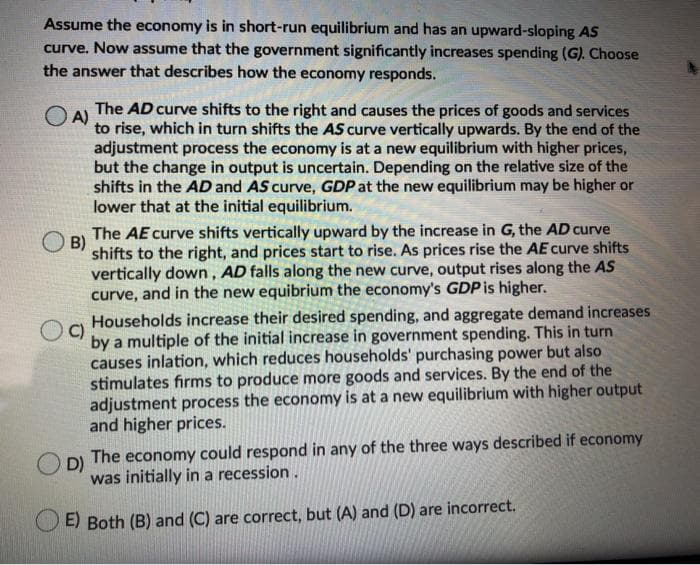Assume the economy is in short-run equilibrium and has an upward-sloping AS curve. Now assume that the government significantly increases spending (G). Choose the answer that describes how the economy responds. The AD curve shifts to the right and causes the prices of goods and services to rise, which in turn shifts the AS curve vertically upwards. By the end of the OA) adjustment process the economy is at a new equilibrium with higher prices, but the change in output is uncertain. Depending on the relative size of the shifts in the AD and AS curve, GDP at the new equilibrium may be higher or lower that at the initial equilibrium. The AE curve shifts vertically upward by the increase in G, the AD curve B) shifts to the right, and prices start to rise. As prices rise the AE curve shifts vertically down, AD falls along the new curve, output rises along the AS curve, and in the new equibrium the economy's GDP is higher. Households increase their desired spending, and aggregate demand increases C) by a multiple of the initial increase in government spending. This in turn causes inlation, which reduces households' purchasing power but also stimulates firms to produce more goods and services. By the end of the adjustment process the economy is at a new equilibrium with higher output and higher prices. D) The economy could respond in any of the three ways described if economy was initially in a recession. E) Both (B) and (C) are correct, but (A) and (D) are incorrect.
Assume the economy is in short-run equilibrium and has an upward-sloping AS curve. Now assume that the government significantly increases spending (G). Choose the answer that describes how the economy responds. The AD curve shifts to the right and causes the prices of goods and services to rise, which in turn shifts the AS curve vertically upwards. By the end of the OA) adjustment process the economy is at a new equilibrium with higher prices, but the change in output is uncertain. Depending on the relative size of the shifts in the AD and AS curve, GDP at the new equilibrium may be higher or lower that at the initial equilibrium. The AE curve shifts vertically upward by the increase in G, the AD curve B) shifts to the right, and prices start to rise. As prices rise the AE curve shifts vertically down, AD falls along the new curve, output rises along the AS curve, and in the new equibrium the economy's GDP is higher. Households increase their desired spending, and aggregate demand increases C) by a multiple of the initial increase in government spending. This in turn causes inlation, which reduces households' purchasing power but also stimulates firms to produce more goods and services. By the end of the adjustment process the economy is at a new equilibrium with higher output and higher prices. D) The economy could respond in any of the three ways described if economy was initially in a recession. E) Both (B) and (C) are correct, but (A) and (D) are incorrect.
Chapter9: Demand-side Equilibrium: Unemployment Or Inflation?
Section: Chapter Questions
Problem 3TY
Related questions
Question

Transcribed Image Text:Assume the economy is in short-run equilibrium and has an upward-sloping AS
curve. Now assume that the government significantly increases spending (G). Choose
the answer that describes how the economy responds.
The AD curve shifts to the right and causes the prices of goods and services
O A)
to rise, which in turn shifts the AS curve vertically upwards. By the end of the
adjustment process the economy is at a new equilibrium with higher prices,
but the change in output is uncertain. Depending on the relative size of the
shifts in the AD and AS curve, GDP at the new equilibrium may be higher or
lower that at the initial equilibrium.
The AE curve shifts vertically upward by the increase in G, the AD curve
B)
shifts to the right, and prices start to rise. As prices rise the AE curve shifts
vertically down, AD falls along the new curve, output rises along the AS
curve, and in the new equibrium the economy's GDP is higher.
Households increase their desired spending, and aggregate demand increases
C)
by a multiple of the initial increase in government spending. This in turn
causes inlation, which reduces households' purchasing power but also
stimulates firms to produce more goods and services. By the end of the
adjustment process the economy is at a new equilibrium with higher output
and higher prices.
D)
The economy could respond in any of the three ways described if economy
was initially in a recession.
E) Both (B) and (C) are correct, but (A) and (D) are incorrect.
Expert Solution
This question has been solved!
Explore an expertly crafted, step-by-step solution for a thorough understanding of key concepts.
Step by step
Solved in 2 steps

Knowledge Booster
Learn more about
Need a deep-dive on the concept behind this application? Look no further. Learn more about this topic, economics and related others by exploring similar questions and additional content below.Recommended textbooks for you



Economics (MindTap Course List)
Economics
ISBN:
9781337617383
Author:
Roger A. Arnold
Publisher:
Cengage Learning



Economics (MindTap Course List)
Economics
ISBN:
9781337617383
Author:
Roger A. Arnold
Publisher:
Cengage Learning